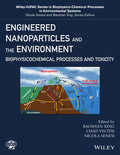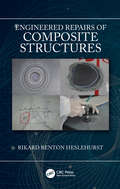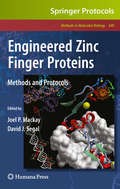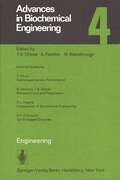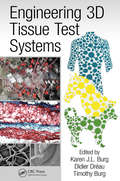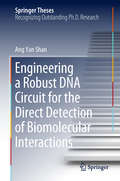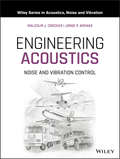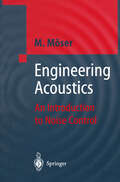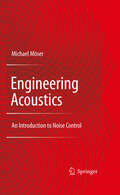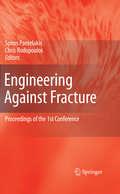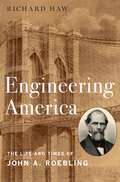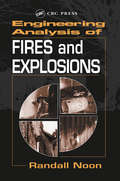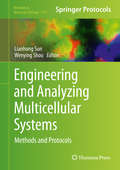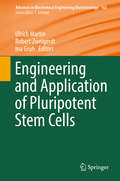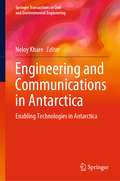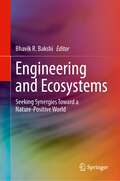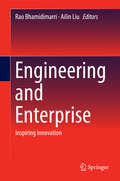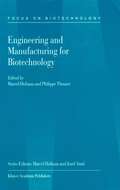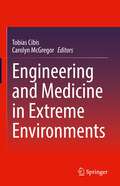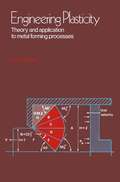- Table View
- List View
Engineered Nanoparticles and the Environment: Biophysicochemical Processes and Toxicity (Wiley Series Sponsored by IUPAC in Biophysico-Chemical Processes in Environmental Systems)
by Baoshan Xing Chad D. Vecitis Nicola SenesiDetails the source, release, exposure, adsorption, aggregation, bioavailability, transport, transformation, and modeling of engineered nanoparticles found in many common products and applications Covers synthesis, environmental application, detection, and characterization of engineered nanoparticles Details the toxicity and risk assessment of engineered nanoparticles Includes topics on the transport, transformation, and modeling of engineered nanoparticles Presents the latest developments and knowledge of engineered nanoparticles Written by world leading experts from prestigious universities and companies
Engineered Repairs of Composite Structures
by Rikard Benton HeslehurstEngineered Repairs of Composite Structures provides a detailed discussion, analysis, and procedures for effective and efficient repair design of advanced composite structures. It discusses the identification of damage types and the effect on structural integrity in composite structures, leading to the design of a repair scheme that focusses on the restoration of the structural integrity and damage tolerance. This book teaches the reader to better understand effective and efficient repair design, allowing for more structurally effective repairs of damaged composite structures. It also discusses the application of the repair and what is needed in the forming of the composite repair to meet the engineering design requirements. Aimed at materials engineers, mechanical engineers, aerospace engineers, and civil engineers, this practical work is a must have for any industry professional working with composite structures.
Engineered Repairs of Composite Structures
by Rikard Benton HeslehurstEngineered Repairs of Composite Structures provides a detailed discussion, analysis, and procedures for effective and efficient repair design of advanced composite structures. It discusses the identification of damage types and the effect on structural integrity in composite structures, leading to the design of a repair scheme that focusses on the restoration of the structural integrity and damage tolerance. This book teaches the reader to better understand effective and efficient repair design, allowing for more structurally effective repairs of damaged composite structures. It also discusses the application of the repair and what is needed in the forming of the composite repair to meet the engineering design requirements. Aimed at materials engineers, mechanical engineers, aerospace engineers, and civil engineers, this practical work is a must have for any industry professional working with composite structures.
Engineered Zinc Finger Proteins: Methods and Protocols (Methods in Molecular Biology #649)
by Joel P. Mackay and David J. SegalAmong the many types of DNA binding domains, C2H2 zinc finger proteins (ZFPs) have proven to be the most malleable for creating custom DNA-binding proteins. In Engineered Zinc Finger Proteins: Methods and Protocols, expert researchers from some of the most active laboratories in this field present detailed methods, guidance, and perspectives. The volume contains sections covering the engineering of ZFPs, methods for the creation, evaluation, and delivery of artificial transcription factors (ATFs), methods for the creation and evaluation of zinc finger nucleases (ZFNs), and a collection of the several applications and assays beyond ATFs and ZFNs, including zinc finger transposases and ChIP-seq methodology amongst other subjects. Written in the highly successful Methods in Molecular Biology™ series format, chapters include introductions to their respective topics, lists of the necessary materials and reagents, step-by-step, readily reproducible laboratory protocols, and notes on troubleshooting and avoiding known pitfalls. Comprehensive and cutting-edge, Engineered Zinc Finger Proteins: Methods and Protocols aims to aid both seasoned practitioners and new investigators with its vital methods and insights as they seek to create the next generation of engineered ZFPs and applications.
Engineering (Advances in Biochemical Engineering/Biotechnology #4)
by Y. Miura B. Atkinson I. S. Daoud P. L. Rogers K. F. O’DriscollEngineering 3D Tissue Test Systems
by Karen J. L. Burg Didier Éau Timothy BurgEngineering 3D Tissue Test Systems provides an introduction to, and unique coverage of, a rapidly evolving area in biomaterials engineering. It reveals the current and future research responses, the current and future diagnostic applications, and provides a comprehensive overview to foster innovation. It offers insight into the importance of 3D systems and their use as benchtop models, spanning applications from basic scientific research to clinical diagnostics. Methods and limitations of building 3D tissue structures are evaluated, with attention given to the cellular, polymeric, and fabrication instrumentation components. The book covers the important aspects of polymeric tissue test systems, highlighting the needs and constraints of the industry, and includes a chapter on regulatory and pricing issues.
Engineering 3D Tissue Test Systems
by Karen J. L. Burg, Didier Dréau and Timothy BurgEngineering 3D Tissue Test Systems provides an introduction to, and unique coverage of, a rapidly evolving area in biomaterials engineering. It reveals the current and future research responses, the current and future diagnostic applications, and provides a comprehensive overview to foster innovation. It offers insight into the importance of 3D systems and their use as benchtop models, spanning applications from basic scientific research to clinical diagnostics. Methods and limitations of building 3D tissue structures are evaluated, with attention given to the cellular, polymeric, and fabrication instrumentation components. The book covers the important aspects of polymeric tissue test systems, highlighting the needs and constraints of the industry, and includes a chapter on regulatory and pricing issues.
Engineering a Robust DNA Circuit for the Direct Detection of Biomolecular Interactions (Springer Theses)
by Ang Yan ShanThis book provides essential insights into designing a localized DNA circuit to promote the rate of desired hybridization reactions over undesired leak reactions in the bulk solution. The area of dynamic DNA nanotechnology, or DNA circuits, holds great promise as a highly programmable toolbox that can be used in various applications, including molecular computing and biomolecular detection. However, a key bottleneck is the recurring issue of circuit leakage. The assembly of the localized circuit is dynamically driven by the recognition of biomolecules – a different approach from most methods, which are based on a static DNA origami assembly. The design guidelines for individual reaction modules presented here, which focus on minimizing circuit leakage, are established through NUPACK simulation and tested experimentally – which will be useful for researchers interested in adapting the concepts for other contexts. In the closing section, the design concepts are successfully applied to the biomolecular sensing of a broad range of targets including the single nucleotide mutations, proteins, and cell surface receptors.
Engineering Acoustics: Noise and Vibration Control (Wiley Series in Acoustics Noise and Vibration)
by Malcolm J. Crocker Jorge P. ArenasA comprehensive evaluation of the basic theory for acoustics, noise and vibration control together with fundamentals of how this theoretical material can be applied to real world problems in the control of noise and vibration in aircraft, appliances, buildings, industry, and vehicles. The basic theory is presented in elementary form and only of sufficient complication necessary to solve real practical problems. Unnecessary advanced theoretical approaches are not included. In addition to the fundamental material discussed, chapters are included on human hearing and response to noise and vibration, acoustics and vibration transducers, instrumentation, noise and vibration measurements, and practical discussions concerning: community noise and vibration, interior and exterior noise of aircraft, road and rail vehicles, machinery noise and vibration sources, noise and vibration in rapid transit rail vehicles, automobiles, trucks, off road vehicles, and ships. In addition, extensive up to date useful references are included at the end of each chapter for further reading. The book concludes with a glossary on acoustics, noise and vibration
Engineering Acoustics: Noise and Vibration Control (Wiley Series in Acoustics Noise and Vibration)
by Malcolm J. Crocker Jorge P. ArenasA comprehensive evaluation of the basic theory for acoustics, noise and vibration control together with fundamentals of how this theoretical material can be applied to real world problems in the control of noise and vibration in aircraft, appliances, buildings, industry, and vehicles. The basic theory is presented in elementary form and only of sufficient complication necessary to solve real practical problems. Unnecessary advanced theoretical approaches are not included. In addition to the fundamental material discussed, chapters are included on human hearing and response to noise and vibration, acoustics and vibration transducers, instrumentation, noise and vibration measurements, and practical discussions concerning: community noise and vibration, interior and exterior noise of aircraft, road and rail vehicles, machinery noise and vibration sources, noise and vibration in rapid transit rail vehicles, automobiles, trucks, off road vehicles, and ships. In addition, extensive up to date useful references are included at the end of each chapter for further reading. The book concludes with a glossary on acoustics, noise and vibration
Engineering Acoustics: An Introduction to Noise Control
by Michael MöserSuitable for both individual and group learning, Engineering Acoustics focuses on basic concepts and methods to make our environments quieter, both in buildings and in the open air. The author’s tutorial style derives from the conviction that understanding is enhanced when the necessity behind the particular teaching approach is made clear. He also combines mathematical derivations and formulas with extensive explanations and examples to deepen comprehension. Fundamental chapters on the physics and perception of sound precede those on noise reduction (elastic isolation) methods. The last chapter deals with microphones and loudspeakers. Moeser includes major discoveries by Lothar Cremer, including the optimum impedance for mufflers and the coincidence effect behind structural acoustic transmission. The appendix gives a short introduction on the use of complex amplitudes in acoustics.
Engineering Acoustics: An Introduction to Noise Control
by Michael MöserSuitable for both individual and group learning, Engineering Acoustics focuses on basic concepts and methods to make our environments quieter, both in buildings and in the open air. The author’s tutorial style derives from the conviction that understanding is enhanced when the necessity behind the particular teaching approach is made clear. He also combines mathematical derivations and formulas with extensive explanations and examples to deepen comprehension. Fundamental chapters on the physics and perception of sound precede those on noise reduction (elastic isolation) methods. The last chapter deals with microphones and loudspeakers. Moeser includes major discoveries by Lothar Cremer, including the optimum impedance for mufflers and the coincidence effect behind structural acoustic transmission. The appendix gives a short introduction on the use of complex amplitudes in acoustics.
Engineering Against Fracture: Proceedings of the 1st Conference
by S. G. Pantelakis C. A. RodopoulosWithin the last thirty years there is a growing acknowledgement that prevention of catastrophic failures necessitates engagement of a large pool of expertise. Herein it is not excessive to seek advice from disciplines like materials science, structural engineering, mathematics, physics, reliability engineering and even economics. Today’s engineering goals, independently of size; do not have the luxury of being outsideaglobalperspective.Survivaloftheintegratedmarketsand?nancialsystems require a web of safe transportation, energy production and product manufacturing. It is perhaps the ?rst decade in engineering history that multidisciplinary - proaching is not just an idea that needs to materialise but has matured beyond infancy. We can witness such transition by examining engineering job descriptions and postgraduate curricula. The undertaking of organising a conference to re?ect the above was not easy and de?nitely, not something that was brought to life without a lot of work and c- st mitment. The 1 Conference of Engineering Against Fracture from its conceptual day until completion was designed in a way of underlying the need of bringing all the key players on a common ground that once properly cultivated can ?ourish. To achieve that the conference themes were numerous and despite their, in principle notional differences, it was apparent that the attendees established such common ground through argumentation. The reader can see this from the variety of research areas re?ected by the works and keynote lecturers presented.
Engineering America: The Life and Times of John A. Roebling
by Richard HawJohn Roebling was one of the nineteenth century's most brilliant engineers, ingenious inventors, successful manufacturers, and fascinating personalities. Raised in a German backwater amid the war-torn chaos of the Napoleonic Wars, he immigrated to the US in 1831, where he became wealthy and acclaimed, eventually receiving a carte-blanche contract to build one of the nineteenth century's most stupendous and daring works of engineering: a gigantic suspension bridge to span the East River between New York and Brooklyn. In between, he thought, wrote, and worked tirelessly. He dug canals and surveyed railroads; he planned communities and founded new industries. Horace Greeley called him "a model immigrant"; generations later, F. Scott Fitzgerald worked on a script for the movie version of his life. Like his finest creations, Roebling was held together by the delicate balance of countervailing forces. On the surface, his life was exemplary and his accomplishments legion. As an immigrant and employer, he was respected throughout the world. As an engineer, his works profoundly altered the physical landscape of America. He was a voracious reader, a fervent abolitionist, and an engaged social commentator. His understanding of the natural world, however, bordered on the occult and his opinions about medicine are best described as medieval. For a man of science and great self-certainty, he was also remarkably quick to seize on a whole host of fads and foolish trends. Yet Roebling held these strands together. Throughout his life, he believed in the moral application of science and technology, that bridges--along with other great works of connection, the Atlantic Cable, the Transcontinental Railroad--could help bring people together, erase divisions, and heal wounds. Like Walt Whitman, Roebling was deeply committed to the creation of a more perfect union, forged from the raw materials of the continent. John Roebling was a complex, deeply divided yet undoubtedly influential figure, and this biography illuminates not only his works but also the world of nineteenth-century America. Roebling's engineering feats are well known, but the man himself is not; for alongside the drama of large scale construction lies an equally rich drama of intellectual and social development and crisis, one that mirrored and reflected the great forces, trials, and failures of nineteenth century America.
Engineering America: The Life and Times of John A. Roebling
by Richard HawJohn Roebling was one of the nineteenth century's most brilliant engineers, ingenious inventors, successful manufacturers, and fascinating personalities. Raised in a German backwater amid the war-torn chaos of the Napoleonic Wars, he immigrated to the US in 1831, where he became wealthy and acclaimed, eventually receiving a carte-blanche contract to build one of the nineteenth century's most stupendous and daring works of engineering: a gigantic suspension bridge to span the East River between New York and Brooklyn. In between, he thought, wrote, and worked tirelessly. He dug canals and surveyed railroads; he planned communities and founded new industries. Horace Greeley called him "a model immigrant"; generations later, F. Scott Fitzgerald worked on a script for the movie version of his life. Like his finest creations, Roebling was held together by the delicate balance of countervailing forces. On the surface, his life was exemplary and his accomplishments legion. As an immigrant and employer, he was respected throughout the world. As an engineer, his works profoundly altered the physical landscape of America. He was a voracious reader, a fervent abolitionist, and an engaged social commentator. His understanding of the natural world, however, bordered on the occult and his opinions about medicine are best described as medieval. For a man of science and great self-certainty, he was also remarkably quick to seize on a whole host of fads and foolish trends. Yet Roebling held these strands together. Throughout his life, he believed in the moral application of science and technology, that bridges--along with other great works of connection, the Atlantic Cable, the Transcontinental Railroad--could help bring people together, erase divisions, and heal wounds. Like Walt Whitman, Roebling was deeply committed to the creation of a more perfect union, forged from the raw materials of the continent. John Roebling was a complex, deeply divided yet undoubtedly influential figure, and this biography illuminates not only his works but also the world of nineteenth-century America. Roebling's engineering feats are well known, but the man himself is not; for alongside the drama of large scale construction lies an equally rich drama of intellectual and social development and crisis, one that mirrored and reflected the great forces, trials, and failures of nineteenth century America.
Engineering Analysis of Fires and Explosions
by Randall K. NoonEngineering Analysis of Fires and Explosions demonstrates how professional forensic engineers apply basic concepts and principles from engineering and scientific disciplines to analyze fires and explosions. It describes how forensic engineers use a "reverse design" process to determine the original cause of a fire or explosion. This guide incorporates practices and lessons learned from the first-hand experiences of the author and his colleagues. It is an exciting introduction to the multidisciplinary subject of fire and explosion analysis and its legal ramifications. The author's straightforward language and style make the concepts easy to understand.
Engineering Analysis of Fires and Explosions
by Randall K. NoonEngineering Analysis of Fires and Explosions demonstrates how professional forensic engineers apply basic concepts and principles from engineering and scientific disciplines to analyze fires and explosions. It describes how forensic engineers use a "reverse design" process to determine the original cause of a fire or explosion. This guide incorporates practices and lessons learned from the first-hand experiences of the author and his colleagues. It is an exciting introduction to the multidisciplinary subject of fire and explosion analysis and its legal ramifications. The author's straightforward language and style make the concepts easy to understand.
Engineering and Analyzing Multicellular Systems: Methods and Protocols (Methods in Molecular Biology #1151)
by Lianhong Sun and Wenying ShouEngineering Multicellular Systems: Methods and Protocols, focuses on laboratory procedures used in recent efforts for constructing synthetic multicellular systems and their applications. In particular, constructing multicellular systems to form various microbial ecosystems has been extensively explored to examine evolution and interactions of microbial ecosystems, while co-cultures have emerged as an efficient tool to produce some complex chemical molecules. Written in the highly successful Methods in Molecular Biology series format, chapters include introductions to their respective topics, lists of the necessary materials and reagents, step-by-step, readily reproducible laboratory protocols and key tips on troubleshooting and avoiding known pitfalls.Engineering Multicellular Systems: Methods and Protocols provide a comprehensive laboratory protocol reference for constructing multicellular systems for various applications.
Engineering and Application of Pluripotent Stem Cells (Advances in Biochemical Engineering/Biotechnology #163)
by Ulrich Martin Robert Zweigerdt Ina GruhThis book reviews the latest biotechnological advances with pluripotent stem cells, exploring their application in tissue engineering and medicinal chemistry. Chapters from expert contributors cover topics such as the production of transgene-free induced pluripotent stem cells (iPSCs), expansion, controlled differentiation and programming of pluripotent stem cells, and their genetic instability. Particular attention is given to the application of the pluripotent stem cells for vascularision of engineered tissue and for drug screening.This book will appeal to researchers working in regenerative medicine and drug discovery, and to bioengineers and professionals interested in stem cell research.
Engineering and Communications in Antarctica: Enabling Technologies in Antarctica (Springer Transactions in Civil and Environmental Engineering)
by Neloy KhareIndia launched its maiden scientific expedition to Antarctica way back in 1981 and ever since annual expeditions are launched to address thematic research in the contemporary areas of Antarctic Science and Engineering. The initial efforts and achievements of India are not only significant but are of historical importance.This book discusses a wide array of topics that have entered the mainstream of geotechnical and geo environmental engineering over the initial two and half decades of India’s presence in the icy continent ‘Antarctica’. At the same time, it highlights the lessons learnt in cryo-engineering technologies. It covers various articles on many aspects of environmental science and collates the overall achievements in the fascinating field of Antarctic engineering and environmental impact assessment. Accordingly, this book covers articles on wind energy by Ramesh et al., and engineering aspects in Antarctica by Rai. Similarly, Pathak has reviewed the engineering details of Dakshin Gangotri and Maitri. On the contrary, Sharma has provided an interesting history about the process of establishment of Dakshin Gangotri station. Similarly, communication aspects have been highlighted by Dhaka. Commercial polymers and their utility in cold region have been discussed by Dabholker et al. Besides, Tiwari and Khare have reviewed the environmental studies carried out during the initial 25 years in Antarctic research base ‘Maitri’. Similarly, Ramchandran and Sathe have studied the natural radioactivity in Antarctica while fire safety in Antarctica has been touched upon by Chatterjee. On the other hand, Veerbhadraiah and Jain have provided a status on environmental management services at Maitri station Additionally Tiwari has provided details on the new Indian Research Base ‘Bharti’ at Larsemann Hills region. It provides a one-stop reference for researchers and those working in industry and government.
Engineering and Ecosystems: Seeking Synergies Toward a Nature-Positive World
by Bhavik R. BakshiThis book demonstrates how the inclusion of nature in engineering decisions results in innovative solutions that are economically feasible, ecologically viable, and socially desirable. It advances progress toward nature-positive decisions by protection and restoration of ecosystems and respect for ecological boundaries. The topic of this book is an active area of academic research, and leading companies are including goals associated with ecosystem services in their sustainability plans. This book is the first collection of methods and applications that explicitly include the role of nature in supporting engineering activities and describes the role that ecosystems play in supporting technology and industry. It describes approaches, models, applications, and challenges for innovation and sustainability that will be useful to students and practitioners.
Engineering and Enterprise: Inspiring Innovation
by Rao Bhamidimarri Ailin LiuThis book presents contributions from researchers, practitioners and professional institutions that published papers in the Proceedings of the Educating Enterprising Engineers and Scientists conference, held in London, UK on 17th June 2015. The topics considered range from educating engineers to giving a business edge and embedding entrepreneurship to achieve integrated education and curriculum innovation. Making an important contribution to the development and delivery of engineering education now and further into the future, this collection of papers shares knowledge and good practice in key ways to educate enterprising engineers and scientists looking to address complex global issues such as health & well-being, water, energy and food. Seeking ways to redefine and embrace sustainable development, this work puts forward the case for innovative science and engineering education to meet the demand for talent and leadership.
Engineering and Manufacturing for Biotechnology (Focus on Biotechnology #4)
by M. Hofman P. ThonartEarly integration is the key to success in industrial biotechnology. This is as true when a selected wild-type organism is put to work as when an organism is engineered for a purpose. The present volume Engineering and Manufacturing for Biotechnology took advantage of the 9th European Congress on Biotechnology (Brussels, Belgium, July 11-15, 1999): in the topics handled and in the expertise of the contributors, the engineering science symposia of this congress offered just what was needed to cover the important topic of integration of process engineering and biological research. The editors have solicited a number of outstanding contributions to illustrate the intimate interaction between productive organisms and the numerous processing steps running from the initial inoculation to the packaged product. Upstream processing of the feed streams, selection of medium components, product harvesting, downstream processing, and product conditioning are just a few major steps. Each step imposes a number of important choices. Every choice is to be balanced against time to market, profitability, safety, and ecology.
Engineering and Medicine in Extreme Environments
by Tobias Cibis Carolyn McGregor AmThis book brings together in-depth information on a wide array of bio-engineering topics and their application to enhance human health, performance, comfort, and survival in extreme environments. Contributions from biomedical engineering, information systems, medicine and physiology, and medical engineering are presented in relation to a broad range of harsh and extreme environmental scenarios, including underwater, terrestrial (both natural and man-made), and space travel. Physicians, engineers, and scientists, as well as researchers and graduate students, will find the book to be an invaluable resource.Details effects of extreme environments on human physiology;Presents human-environment interaction in different scenarios;Overview of engineering challenges and problems in extreme environments.
